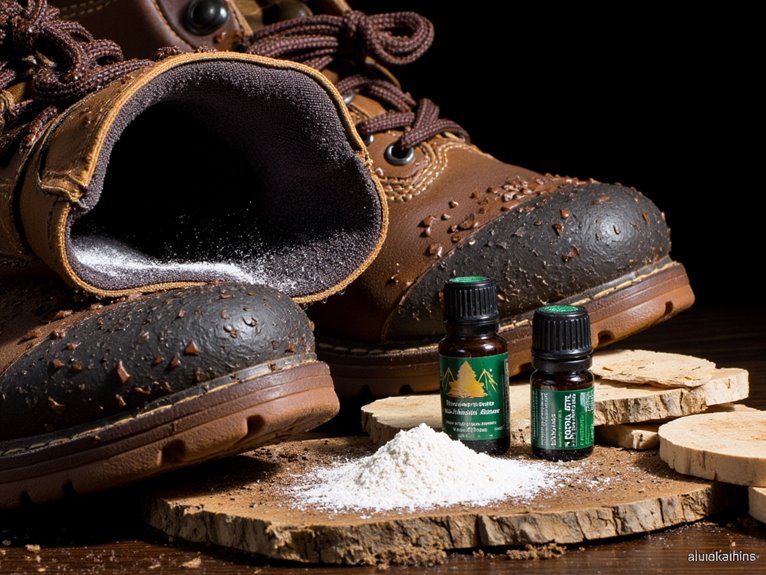Managing Odor and Fungus in Backpacking Footwear
You’ll prevent odor and fungal growth in backpacking boots by controlling moisture and bacteria through targeted strategies. Apply foot antiperspirant before hikes to reduce sweat by 30-40%, then use antibacterial sprays containing benzalkonium chloride after each trek. Remove insoles nightly and sprinkle baking soda inside boots for moisture absorption. For persistent fungal issues, apply diluted vinegar solution (20% vinegar, 80% water). Store boots in ventilated areas and stuff with newspaper when wet. Advanced antimicrobial technologies and specialized maintenance techniques offer even greater protection.
We are supported by our audience. When you purchase through links on our site, we may earn an affiliate commission, at no extra cost for you. Learn more. Last update on 16th December 2025 / Images from Amazon Product Advertising API.
Notable Insights
- Apply foot antiperspirant before hikes and use moisture-wicking socks to reduce sweat production by 30-40%.
- Remove insoles and shoelaces after each hike, then clean boots with lukewarm water and mild soap.
- Sprinkle baking soda in boots overnight to absorb moisture and neutralize odor-causing bacterial acids.
- Use diluted vinegar solution (20% vinegar, 80% water) for persistent fungal infections like athlete’s foot.
- Air-dry boots at room temperature in well-ventilated areas, avoiding heat sources that can damage materials.
Understanding the Root Causes of Footwear Odor and Fungal Growth
When you experience persistent foot odor or notice signs of fungal infection, the underlying causes stem from a complex interaction between moisture, microbial activity, and environmental conditions.
Your feet contain more sweat glands than any other body part, producing significant daily moisture. This sweat creates an ideal breeding ground for bacteria and fungi inside your boots.
Your feet’s abundant sweat glands create the perfect storm of moisture that transforms your boots into bacterial and fungal breeding grounds.
Effective moisture management becomes critical during multi-day treks. Bacteria metabolize your sweat, producing acids that cause bromodosis—the technical term for foot odor.
Understanding fungal biology reveals how these organisms thrive in dark, warm environments. Athlete’s foot fungi break down your skin’s protective barrier, allowing bacterial invasion that intensifies odor.
This microbial colonization creates a self-sustaining cycle where fungal damage provides nutrients for bacteria, generating increasingly complex and unpleasant chemical compounds. Certain bacterial strains like Kyetococcus sedentarius can produce particularly offensive odors that smell like rotten eggs. The intensity of foot odor can serve as an indicator of infection progression, with stronger smells potentially signaling more serious bacterial complications.
Essential Prevention Strategies for Clean and Fresh Boots
Five proven prevention strategies can eliminate boot odor and fungal growth before problems develop. These techniques target moisture control and antibacterial options at their source.
Start with proper sock selection using moisture-wicking polyester blends instead of cotton. Apply foot antiperspirant before hiking to reduce sweat production by 30-40%. Use antibacterial sprays containing benzalkonium chloride after each hike.
| Strategy | Product Type | Application Frequency |
|---|---|---|
| Moisture Control | Antiperspirant spray | Before each hike |
| Antibacterial Treatment | Boot spray/powder | After each use |
| Sock Management | Synthetic moisture-wicking | Daily changes |
| Storage Protocol | Ventilated drying area | Every use |
| Interior Maintenance | Removable insoles | Weekly cleaning |
Store boots in ventilated areas with removable insoles. Sprinkle baking soda overnight for moisture absorption. These prevention methods cost considerably less than boot replacement. Choose hiking footwear with machine washable capabilities and practical mesh ventilation to maintain freshness throughout your adventures.
Effective Cleaning and Deodorizing Methods
After identifying moisture and bacterial buildup in your boots, you’ll need systematic cleaning methods that target both surface contamination and embedded odors.
Remove shoelaces and insoles first to access hidden areas where bacteria thrive. Use lukewarm water with mild soap or specialized boot cleaners designed for your specific shoe materials. Avoid harsh detergents that damage waterproof membranes and leather fibers.
Start by removing shoelaces and insoles to expose bacteria-prone areas, then clean with lukewarm water and gentle, material-appropriate cleaners.
Apply baking soda overnight inside footwear to neutralize odors and absorb residual moisture. For persistent fungal issues, use a diluted vinegar solution containing 20% white vinegar and 80% water. Scrub gently with soft brushes, focusing on fabric and mesh areas without oversaturating materials.
Cleaning frequency depends on usage intensity, but rinse boots after each significant trek to prevent contamination buildup that encourages bacterial growth.
Advanced Products and Technologies for Odor Control
While basic cleaning methods handle immediate contamination, advanced odor control technologies offer long-term solutions that work continuously inside your footwear.
These systems target specific compounds like ammonia, acetic acid, and isovaleric acid that create persistent odors. Advanced materials incorporate antimicrobial agents directly into footbed construction, while innovative designs integrate moisture-wicking properties with bacterial neutralization.
Microban Freshology uses plant extracts and minerals to inhibit odor-causing bacteria growth. Microbial-based systems like Kodiak SOS employ beneficial microbes that biologically break down odor sources rather than masking them.
These technologies meet international standards GB/T 33610 and ISO 17299 for textile odor control effectiveness. Similar silica gel technology found in moisture absorbers can be integrated into footwear systems to provide continuous humidity control that prevents bacterial growth.
- Specialized insoles with activated carbon and charcoal filtration
- Antimicrobial boot sprays providing 6-12 months protection
- Dual-density polyurethane midsoles with integrated odor control
- Patent-pending plant extract formulations targeting specific odorants
- Rechargeable natural charcoal systems activated by sunlight exposure
Proper Maintenance and Storage Techniques
Three fundamental maintenance practices determine whether your footwear remains odor-free and fungus-resistant: systematic cleaning protocols, controlled drying procedures, and proper storage environments.
Effective shoe care begins with immediate post-hike cleaning. Remove shoelaces and insoles first, then brush off dried mud to prevent fiber abrasion.
Use specialized footwear cleaning gels like Nikwax products—avoid petroleum-based solvents that damage materials. Rinse thoroughly after cleaning to eliminate residues.
Air-dry shoes at room temperature only. Heaters and hair dryers cause cracking and sole separation. Stuff wet shoes with newspaper immediately, changing absorbent material regularly until completely dry.
Smart storage solutions require cool, dry locations with adequate ventilation.
Never use sealed plastic bags—they trap humidity and encourage mold growth. Store shoes away from direct sunlight to prevent material degradation and maintain structural integrity.
Frequently Asked Questions
Can I Use My Hiking Boots Immediately After Treating Them for Odor?
No, you shouldn’t use your hiking boots immediately after odor treatment. Proper boot care requires complete drying first, typically 4-24 hours, to prevent moisture trapping and odor recurrence.
How Do I Know if Foot Odor Indicates a Serious Medical Condition?
You’ll know foot odor indicates serious issues if it persists despite good hygiene, accompanies rashes or blistering, smells unusually sweet or moldy, or involves excessive sweating. Seek medical advice for proper foot health evaluation.
Are There Natural Alternatives to Commercial Antifungal Sprays for Boots?
Yes, you can use tea tree oil mixed with water as a natural antifungal spray. Baking soda sachets absorb moisture and inhibit fungus. White vinegar sprays and vodka mists also eliminate odor-causing microbes effectively.
On a final note
You’ve learned the essential strategies for maintaining odor-free backpacking footwear. Prevention through moisture management and proper sock selection remains your first defense. Regular cleaning with antimicrobial treatments eliminates existing bacteria and fungi. Advanced technologies like UV sanitizers and moisture-wicking insoles provide additional protection. Proper storage in ventilated areas prevents future growth. These techniques will keep your boots fresh and extend their lifespan during extended wilderness expeditions.

